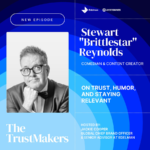From Web to App: Why the Next Wave of Business Growth Lives Inside Mobile Apps
By Phoena Pang, VP of Sales & Operations, Americas, Mintegral
Consumers live in a mobile world. According to Deloitte, 96% of consumers own a smartphone and prefer to use them to browse shopping websites and make purchases. This means that businesses that do not prioritize the creation of mobile apps and put resources behind mobile marketing could find themselves well behind the curve.
In every industry you look, mobile apps are increasing their influence on customers. According to eMarketer, global retail mobile commerce sales reached nearly $4.5 trillion in 2024, accounting for almost 70% of total retail e-commerce sales. Why? 37% of retail customers regularly use mobile apps to make purchases, according to Forrester.
In the financial services industry, more than half of customers say the mobile app is their favorite way to interact with their bank, according to the American Banking Association. The same is true for retailers.
The evidence is clear: companies need to invest in apps as a way to own relationships with existing customers and grow user acquisition initiatives.
Mobile apps offer brands more opportunities to drive deeper relationships with their customers. Here are some best practices for brands looking to enhance their app marketing game to build a moat against competitors and grow their business among mobile-first customers.
Boost retention with intuitive features
Brands can enhance app stickiness through an intuitive UX and features like push notifications and loyalty programs. They can also employ new tech, such as Augmented Reality (AR), to create experiences that customers can’t unlock anywhere else.
For example, IKEA has integrated AR technology into its app to enhance its IKEA Kreativ platform, allowing users to visualize furniture in their homes before making a purchase. While desktop purchasers can create virtual showrooms of room types, the mobile app opens up the potential for AR, letting users see how furniture would look in their own homes.
As part of a $65 million investment in technological enhancements, Australian department store David Jones launched a new mobile shopping app that offers personalized notifications, product recommendations, express checkout, live chat features, and loyalty programs. Through a partnership with Qantas, David Jones will allow users to earn and redeem either David Jones Rewards Points or Qantas Points through its new app.
Kroger helps app users improve their health with “OptUP,” which scores purchases based on their holistic health scores and can make substitution recommendations.
As consumers become increasingly comfortable with developing technology, forward-thinking companies can identify multiple ways to extend their brands and deepen customer relationships.
Make mobile the preferred way to interact with the brand
Starbucks’ mobile app has become a cornerstone of its customer engagement strategy for one key reason: it tightly integrates its mobile payments with its robust loyalty program. In fat, their loyalty program has led to a 32% growth in active mobile users, demonstrating the app’s effectiveness in driving sales and customer retention. As of today, at least 30% of Starbucks’ U.S. transactions occur in the app.
Similarly, McDonald’s is well known for steep app-specific discounts that encourage customers to order through its app and to receive push notifications. This system creates a feedback loop that entices customers to make McDonald’s their preferred lunchtime option. McDonald’s predominantly mobile-based loyalty program had 175 million members, driving about $30 billion in sales in 2024.
Providing loyalty- or discount-based reasons for customers to download and pay with their mobile apps is a great way to keep top of mind when they’re on the go.
Prioritize app-centric acquisition
According to eMarketer, mobile advertising spend in the US in 2025 is expected to reach $228 billion. This will represent a 12% year-over-year increase in mobile ad spend. Brands have several options to invest their spend, and keep up with competition, including in-app, rich media, interstitials, and native ads.
Overall, mobile advertising offers brands the opportunity to create more engaging and interactive calls to action that can capture mobile users’ attention mid-activity and encourage them to download and use their brand’s app. Enacting this strategy only enables new growth.
Grow first-party data for smarter targeting
Speaking of growth, let’s touch on the unparalleled access mobile apps have to first-party data. The above app-exclusive discounts and loyalty programs not only improve customer convenience but also provide valuable data for targeted marketing campaigns.
Brands should go beyond mere loyalty programs to grow their first-party data. Offering incentives for referrals, conducting surveys, and gamifying in-app interactions are all ways to improve the information companies have about their customers. This not only improves the company’s mobile offering, but it also improves their ability to offer advertising opportunities to partners on the app.
The key is to build strategies that maximize data gathering and then apply this data to segment users, tailor offers, and improve campaign performance. Nike’s SNKRS app offers “drops” of limited-edition sneakers, helping to identify truly passionate fans and track their interests, enabling segmentation for different offers in the future, benefiting app and user alike.
Grow your app revenue through targeted advertising
Ever since the advent of retail media, brands of all sizes are looking to launch their own media networks as a way to better monetize their audiences. McKinsey predicts that retail media will reach $1.3 trillion in enterprise value by 2026.
For example, Chase Media Solutions gives advertisers the opportunity to target customers based on spending data collected through its mobile app. This initiative enhances personalized marketing efforts and opens new revenue streams by leveraging first-party data.
Mobile will only grow in importance
As consumers spend an increasing amount of time on mobile devices, brands that invest in robust app experiences are building stronger customer relationships, richer data pipelines, and more resilient revenue streams.
But creating and launching an app is only the first step. Companies need to provide incentives for customers to use their app, invest in user acquisition, collect first-party data to strengthen their marketing, and explore opportunities to monetize their audience through tailored advertising opportunities.











